
Dimorphotheca pluvialis, common names white African daisy, Cape marigold, weather prophet, Cape rain-daisy, ox-eye daisy, Cape daisy or rain daisy, is a plant species native to South Africa and Namibia. It is sparingly naturalized in scattered locations in California.

Leucadendron tinctum, the spicy conebush, is a flower-bearing shrub that belongs to the genus Leucadendron and forms part of the fynbos. The plant is native to the Western Cape, where it occurs in the Hex River Mountains up to Hottentots Holland Mountains and Langeberg. The shrub grows 1.3 m tall and bears flowers from July to August.

Protea subvestita, the waterlily sugarbush, is a flower bearing shrub that belongs to the well-known genus Protea. The plant is native to Lesotho and South Africa and occurs in Mpumalanga on the escarpment of the Wakkerstroom, Free State, KwaZulu-Natal, Eastern Cape, and the Klein Swartberg. The shrub is large, erect and grows up to 5 m. It flowers mainly from January to March.
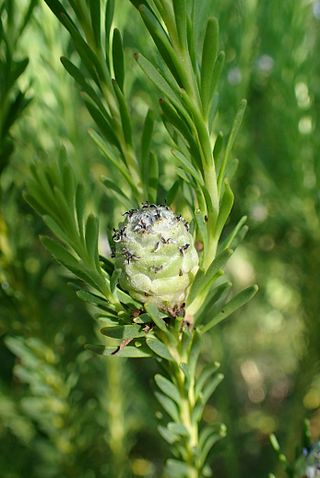
Leucadendron linifolium, the line-leaf conebush, is a flower-bearing shrub that belongs to the genus Leucadendron and forms part of the fynbos. The plant is native to the Western Cape, South Africa.

Leucadendron loeriense, the Loerie conebush, is a flower-bearing shrub that belongs to the genus Leucadendron and forms part of the fynbos. The plant is native to the Western Cape, where it is found in the Elandsberg, Baviaanskloof and Groot-Winterhoek mountains. The shrub grows 2.5 m tall and flowers in December and January.

Leucadendron rubrum, the spinning top, is a flower-bearing shrub belonging to the genus Leucadendron and forms part of the fynbos. The plant is native to the Western Cape, South Africa.

Leucadendron floridum, the flats conebush, is a flower-bearing shrub belonging to the genus Leucadendron and forms part of the fynbos. The plant is native to the Western Cape, where it occurs in the Cape Flats, from Rondebosch to Kuils River and also in the Cape Peninsula around most wetlands. The shrub grows 2 m tall and bears flowers from September to October.
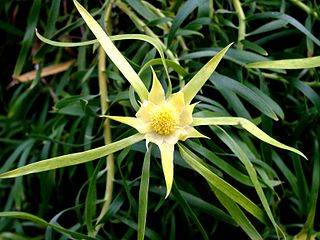
Leucadendron eucalyptifolium, the gum-leaved conebush, is a flower-bearing shrub belonging to the genus Leucadendron and forms part of the fynbos. The plant is native to the Western Cape and the Eastern Cape, where it occurs in the Potberg, Riversdal Plains, Langeberg, Outeniqua Mountains, Tsitsikamma Mountains, Kouga Mountains, Elandsberg, Swartberg, Waboomsberg, Warmwaterberg, Touwsberg, Rooiberg and Soetwaterberg. The shrub grows 4 m tall and bears flowers from July to October.
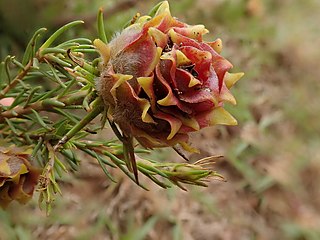
Leucadendron laxum, the Bredasdorp conebush, is a flower-bearing shrub belonging to the genus Leucadendron and forms part of the fynbos. The plant is native to the Western Cape, South Africa, where it occurs from Hermanus to Agulhas.

Leucadendron levisanus, commonly known as the Cape flats conebush, is a flower-bearing shrub that belongs to the genus Leucadendron and forms part of the fynbos. The plant is native to the Western Cape, where it occurs in the Cape Flats from Vishoek to Eerste River and Mamre. The shrub grows 2 m tall and bears flowers in October.

Dimorphotheca acutifolia is a plant belonging to the genus Dimorphotheca. The species is native to the Eastern and Western Cape Provinces.
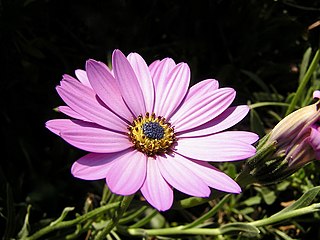
Dimorphotheca barberae is a species of flowering plant in the family Asteraceae. The species is endemic to the Eastern Cape in South Africa.
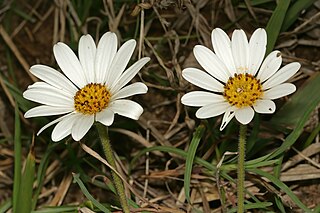
Dimorphotheca caulescens is a species of flowering plant in the family Asteraceae. The species is endemic to the Eastern Cape, Western Cape and the Free State.

Dimorphotheca chrysanthemifolia is a plant belonging to the genus Dimorphotheca. The species is endemic to the Western Cape.

Dimorphotheca montana is a plant belonging to the genus Dimorphotheca. The species is endemic to the Western Cape.
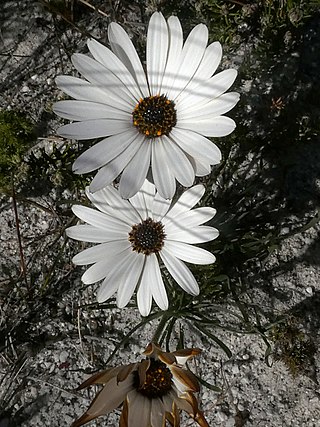
Dimorphotheca nudicaulis is a plant that belongs to the genus Dimorphotheca. The species is endemic to the Northern Cape and the Western Cape.
Dimorphotheca polyptera is a plant belonging to the genus Dimorphotheca. The species is native to the Northern Cape, Western Cape and Namibia.

Dimorphotheca tragus is a plant that belongs to the genus Dimorphotheca. The species is endemic to the Northern Cape and the Western Cape.

Dimorphotheca venusta is a plant belonging to the genus Dimorphotheca. The species is endemic to the Western Cape and occurs in the Wemmershoek, Du Toitskloof and Hexrivier mountains at altitudes of 600 - 1,800 m. The plant is considered rare. The species was described by Nils Tycho Norlindh in 1980.
Dimorphotheca walliana is a plant belonging to the genus Dimorphotheca. The species is endemic to the Western Cape and occurs at Gordon's Bay at the foot of the Hottentots Holland Mountains. It has an area of occurrence of only 20 km² and there are two subpopulations that are part of the fynbos. The species is threatened by coastal development.



















